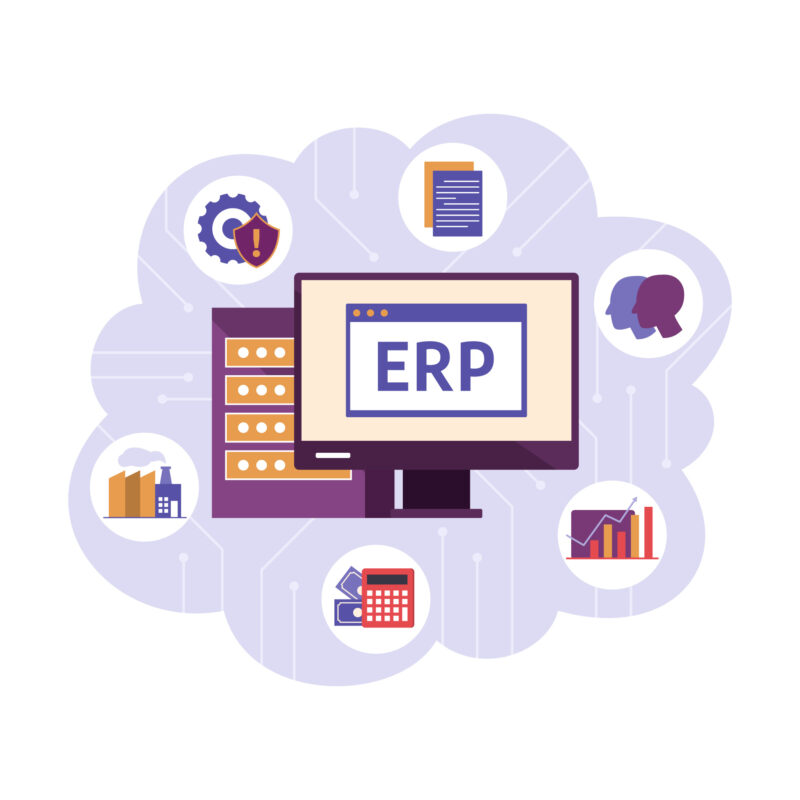In today’s digital era, businesses are constantly seeking ways to enhance their online presence and reach a wider audience. One of the key strategies that companies are leveraging is the integration of IT consultancy services into their digital marketing efforts. By intelligently combining IT expertise with marketing strategies, businesses can maximize efficiency and achieve greater success in the competitive online landscape. The Role of IT Consultancy in Digital Marketing IT consultancy plays a crucial role in helping businesses optimize their digital marketing strategies. IT consultants bring a wealth of technical knowledge and expertise that can help businesses streamline their online operations, improve website performance, and enhance user experience. By leveraging IT consultancy services, businesses can stay ahead of the curve and adapt to the rapidly evolving digital landscape. Benefits of Integrating IT Consultancy into Digital Marketing Improved website performance and speed Enhanced cybersecurity measures Optimized digital infrastructure Effective data analytics and insights By intelligently incorporating IT consultancy into their digital marketing strategies, businesses can achieve greater efficiency and effectiveness in reaching their target audience and driving conversions. Case Study: Success Story One example of a company that has successfully integrated IT consultancy into its digital marketing strategies is Ribbitz LLC. Ribbitz LLC has mastered the intersection of digital marketing and IT services, amplifying its success in the digital era. To learn more about Ribbitz LLC’s approach, you can visit their website here. Future Trends in Digital Marketing and IT As technology continues to advance, the intersection of digital marketing and IT will become increasingly important for businesses looking to stay competitive in the digital landscape. By staying informed about the latest trends and innovations in both fields, businesses can position themselves for success and maximize efficiency in their online marketing efforts. For more insights on the latest trends in technology and digital marketing, you can check out this article on ReadWrite. Conclusion Integrating IT consultancy into digital marketing strategies is essential for businesses looking to maximize efficiency and achieve success in the digital era. By leveraging IT expertise and staying ahead of the curve, businesses can enhance their online presence, reach a wider audience, and drive conversions effectively.
Author Archives: ribbitzadmin
Project management is crucial for the success of any digital marketing and IT consultancy project. It involves planning, organizing, and executing tasks to achieve specific goals within a set timeframe and budget. In this blog post, we will discuss 10 essential project management strategies that can help you effectively manage your digital marketing and IT consultancy projects. 1. Define Clear Objectives Before starting any project, it is important to define clear objectives. This will help you and your team understand what needs to be achieved and how success will be measured. 2. Create a Detailed Project Plan A detailed project plan outlines the tasks, timelines, resources, and responsibilities involved in the project. It helps in keeping track of progress and ensuring that the project stays on schedule. 3. Use Project Management Tools Utilize project management tools such as Trello, Asana, or Jira to streamline communication, track progress, and manage tasks efficiently. 4. Establish Clear Communication Channels Effective communication is key to successful project management. Establish clear communication channels to ensure that all team members are on the same page and informed about project updates. 5. Set Realistic Deadlines Set realistic deadlines for each task to avoid delays and ensure that the project is completed on time. 6. Monitor Progress Regularly Regularly monitor the progress of the project to identify any potential issues or bottlenecks and take corrective actions as needed. 7. Allocate Resources Wisely Allocate resources such as budget, manpower, and technology wisely to ensure that the project is executed efficiently. 8. Manage Risks Effectively Identify potential risks and develop strategies to mitigate them to minimize any negative impact on the project. 9. Conduct Regular Team Meetings Hold regular team meetings to discuss progress, address any issues, and ensure that everyone is aligned with the project goals. 10. Evaluate and Learn from Each Project After completing a project, evaluate its success and areas for improvement. Use these insights to learn and enhance your project management strategies for future projects. By implementing these 10 essential project management strategies, you can effectively manage your digital marketing and IT consultancy projects and ensure their success. For more insights on digital marketing and IT consultancy, visit Ribbitz LLC. Read more about the latest trends in AI and digital marketing on ReadWrite.
Project management is a crucial aspect of IT consultancy in the digital marketing and IT industry. It involves planning, organizing, and executing projects effectively to achieve desired outcomes. In this guide, we will explore the key principles and strategies for successful project management in IT consultancy. The Importance of Project Management in IT Consultancy Effective project management is essential for IT consultancy firms to deliver high-quality services to their clients. It helps in ensuring that projects are completed on time, within budget, and meet the client’s requirements. By following best practices in project management, IT consultancy firms can enhance their reputation, build client trust, and achieve long-term success. Key Principles of Project Management in IT Consultancy Clear Project Objectives: Define clear and achievable project objectives at the outset to guide the project team throughout the project lifecycle. Effective Communication: Establish open and transparent communication channels to ensure all stakeholders are informed and engaged throughout the project. Risk Management: Identify potential risks and develop mitigation strategies to minimize the impact of unforeseen events on the project. Resource Allocation: Allocate resources effectively to ensure that the project is adequately staffed and equipped to meet its objectives. Quality Assurance: Implement quality assurance processes to maintain high standards of deliverables and meet client expectations. Strategies for Successful Project Management in IT Consultancy Implementing the following strategies can help IT consultancy firms achieve success in project management: Utilize Project Management Tools: Invest in project management software to streamline project planning, tracking, and reporting. Collaborate with Clients: Involve clients in the project planning and decision-making process to ensure alignment with their goals and expectations. Continuous Improvement: Regularly review project performance and outcomes to identify areas for improvement and implement corrective actions. Training and Development: Provide ongoing training and development opportunities for project team members to enhance their skills and capabilities. By following these principles and strategies, IT consultancy firms can unlock success in project management and deliver exceptional results to their clients. For professional IT solutions and services, including Java developer services, visit Ribbitz LLC. Read more about the latest trends in the digital marketing and IT industry on ReadWrite.
IT consultancy plays a crucial role in the success of digital marketing projects. With the rapid evolution of technology and the digital landscape, businesses need expert guidance to navigate the complexities of digital marketing. In this blog post, we will explore the essential strategies for project management success in IT consultancy for digital marketing. The Importance of IT Consultancy in Digital Marketing IT consultancy brings a wealth of knowledge and expertise to digital marketing projects. Consultants help businesses leverage technology to optimize their marketing strategies, improve efficiency, and achieve their goals. By partnering with IT consultants, businesses can stay ahead of the competition and adapt to the ever-changing digital landscape. Essential Strategies for Project Management Success 1. Define Clear Objectives Before embarking on a digital marketing project, it is essential to define clear objectives. This includes identifying the target audience, setting measurable goals, and outlining the desired outcomes. Clear objectives provide a roadmap for the project and help ensure that all stakeholders are aligned. 2. Conduct Thorough Research Research is a critical component of successful digital marketing projects. IT consultants should conduct thorough market research, competitor analysis, and audience insights to inform their strategies. By understanding the market landscape, consultants can tailor their approach to meet the specific needs of the target audience. 3. Develop a Comprehensive Strategy Based on the research findings, IT consultants should develop a comprehensive digital marketing strategy. This strategy should outline the tactics, channels, and resources required to achieve the project objectives. A well-defined strategy serves as a roadmap for implementation and helps keep the project on track. 4. Implement Agile Project Management Agile project management methodologies are well-suited for digital marketing projects. Agile allows for flexibility, collaboration, and rapid iteration, which are essential in the fast-paced digital environment. By adopting agile practices, IT consultants can respond quickly to changes and deliver results more efficiently. 5. Monitor and Measure Performance Monitoring and measuring performance are key aspects of project management success in digital marketing. IT consultants should track key performance indicators (KPIs), analyze data, and make data-driven decisions to optimize campaign performance. Regular monitoring allows for course corrections and ensures that the project stays on track. 6. Continuous Improvement and Optimization Continuous improvement is essential for long-term success in digital marketing projects. IT consultants should regularly review performance data, gather feedback, and identify areas for optimization. By continuously refining strategies and tactics, consultants can drive better results and stay ahead of the competition. Conclusion IT consultancy plays a vital role in the success of digital marketing projects. By following the essential strategies outlined in this blog post, IT consultants can effectively manage projects, drive results, and help businesses achieve their marketing goals. With a focus on clear objectives, thorough research, agile project management, and continuous improvement, IT consultants can unlock the power of IT consultancy in digital marketing. For more information on IT consultancy and digital marketing, visit this link. Read more about the latest trends in digital marketing on this external link.
ERP and MRP systems, help organizations reduce business process intricacies and improve operational effectiveness, and optimize inventory levels, hence streamlining all businesses. Nevertheless, it remains one of the systems that is challenging to adopt. The present blog article discusses some common issues business organizations may find themselves encountering during ERP/MRP implementation and integration. Solution for Effective Addressing. Resistance to Change One of the greatest resistance to adopting ERP and MRP systems is that of employees. Most teams are accustomed to existing processes and may fear the learning curve associated with new software. Solution: Communicate the benefits of ERP/MRP systems clearly. Comprehensive training programs. Involving employees in the selection and implementation process can help build trust and acceptance. High Initial Costs ERP and MRP systems require a huge initial investment in terms of software costs, implementation expenses, and training programs. Solution: Conduct a cost-benefit analysis to justify the investment. Explore scalable solutions to spread costs over time. Leverage government grants or incentives for digital transformation. Data Migration Issues Migrating existing data into a new ERP or MRP system can be complex and error-prone. Poor data quality can lead to inaccuracies and inefficiencies. Solution: Audit and clean data before migration. Use automated tools for efficient data migration. Do multiple test migrations to identify and address issues early. Integration Challenges ERP and MRP systems can be technically challenging to integrate with existing software and processes. Compatibility issues may arise, requiring customization or workarounds. Solution: Select ERP/MRP systems with robust APIs and integration capabilities. Work with experienced vendors or consultants for smooth integration. Conduct thorough testing to ensure all systems function seamlessly. Time-Consuming Implementation ERP and MRP system implementations are often longer than envisioned, disrupting daily business processes and delaying ROI. Solution: Create a realistic timeline with clear milestones. Apply agile implementation methodologies to immediately resolve issues. The vendor must provide dedicated support throughout the process. Lack of Training Untrained employees may not fully use the system, hence it gets underutilized, frustrating employees. Solution: Invest in continuous training programs tailored for all levels of users. Provide easily accessible resources like manuals, videos, and webinars. Assign internal champions or super-users who will be able to assist their teams. Scalability and Customization Issues ERP and MRP systems should be responsive to the growth and different requirements of the business. Systems that are not scalable or rigid in terms of customization options are less likely to remain viable over time End. Risk of Cyber Attack Most of the data stored within the ERP and MRP systems contains sensitive business data. Without a robust system for security, the use of such systems may present a risk to the organizations. Solution: Encryption with multi-factor authentication Continuous security updates Employee cybersecurity education Partnering with suppliers that ensure the software meets required standards Non-Vendor Support Lack of proper vendor support will add more weight to problems experienced during the implementation and postimplementation phases of adopting the ERP and MRP systems. Solution: Select vendors with a history of success. Vendor support after implementation should be adequate. SLAs for resolving issues in a timely manner should be negotiated. Unrealistic Expectations Businesses may expect overnight results or overestimate the capabilities of the system, which can lead to disappointment. Solution: Set realistic goals and KPIs for the system’s performance. Understand the limitations of the chosen solution. Review progress regularly and adjust expectations accordingly. ERP and MRP systems can revolutionize businesses if handled properly. Changes such as resistance to it, high costs, data migration, and many other challenges can be handled for a smooth transition and proper incorporation of these systems. All these can be done and maximized only with proper planning and training and vendor support when one is using ERP and MRP systems for their business growth.
In today’s fast-paced digital world, the successful execution of projects requires a seamless integration of digital marketing strategies and IT solutions. The synergy between these two disciplines can significantly enhance project management efficiency and effectiveness. Let’s explore how the intersection of digital marketing and IT can lead to maximizing efficiency in project management. The Role of Digital Marketing in Project Management Digital marketing plays a crucial role in project management by helping to define project goals, identify target audiences, and create effective communication strategies. By leveraging digital marketing tools and techniques, project managers can reach their target audience more effectively, generate leads, and drive conversions. One key aspect of digital marketing in project management is data analytics. By analyzing data from various digital marketing channels, project managers can gain valuable insights into consumer behavior, preferences, and trends. This data-driven approach enables project managers to make informed decisions and optimize project performance. The Impact of IT in Project Management Information technology (IT) is another essential component of project management. IT solutions such as project management software, collaboration tools, and cloud computing platforms streamline project workflows, facilitate communication among team members, and ensure data security. IT also plays a critical role in project monitoring and evaluation. By implementing IT systems that track project progress, identify bottlenecks, and measure key performance indicators, project managers can proactively address issues and make real-time adjustments to ensure project success. The Convergence of Digital Marketing and IT When digital marketing and IT converge in project management, the result is a powerful synergy that maximizes efficiency and drives project success. By integrating digital marketing strategies with IT solutions, project managers can create a cohesive project management framework that leverages the strengths of both disciplines. For example, project managers can use digital marketing tools to analyze market trends and consumer behavior, while IT solutions enable seamless collaboration among team members and efficient project execution. This convergence allows project managers to make data-driven decisions, optimize project workflows, and deliver results that exceed expectations. Maximizing Efficiency in Project Management By intelligently combining digital marketing and IT in project management, organizations can maximize efficiency in various ways: Streamlining project workflows and processes Enhancing communication and collaboration among team members Improving project monitoring and evaluation Optimizing resource allocation and budget management Ultimately, the intersection of digital marketing and IT in project management empowers organizations to achieve their project goals more effectively and efficiently. Conclusion In conclusion, the intersection of digital marketing and IT in project management is a game-changer for organizations looking to maximize efficiency and drive project success. By leveraging the strengths of both disciplines, project managers can create a dynamic project management framework that delivers results and exceeds expectations. Embracing this convergence is key to staying competitive in today’s digital landscape. For more insights on digital marketing and IT in project management, visit Ribbitz LLC. Read more about the latest trends in digital marketing and IT at ReadWrite.
As the digital landscape continues to evolve, businesses are increasingly turning to IT consultancy services to navigate the complexities of digital marketing. In this guide, we will explore the key strategies and best practices that IT consultants can employ to unlock success for their clients in the digital marketing realm. The Role of IT Consultancy in Digital Marketing IT consultancy plays a crucial role in helping businesses leverage technology to achieve their marketing goals. From implementing data analytics tools to optimizing websites for search engines, IT consultants provide the technical expertise needed to drive digital marketing success. Key Strategies for IT Consultants Is WooCommerce Safe? Stay updated with the latest trends and technologies in digital marketing. Collaborate closely with marketing teams to align technology solutions with business objectives. Implement robust cybersecurity measures to protect client data and ensure compliance with regulations. Optimize website performance for speed and user experience. The Future of IT Consultancy in Digital Marketing With the rapid pace of technological innovation, the role of IT consultancy in digital marketing is only set to grow in importance. By staying ahead of the curve and embracing new technologies, IT consultants can continue to unlock success for their clients in the ever-changing digital landscape. For more insights on the intersection of technology and marketing, check out this article on low-cap AI meme coin surges to $5 million in presale, poised for massive growth.
In today’s digital era, the intersection of digital marketing and IT services plays a crucial role in the success of businesses. As technology continues to evolve rapidly, organizations are increasingly relying on IT consultancy and project management expertise to navigate the complex landscape of digital marketing. The Importance of Project Management in Digital Marketing Project management is essential in digital marketing as it ensures that campaigns are executed efficiently, on time, and within budget. A project manager with expertise in IT consultancy can effectively oversee the planning, execution, and monitoring of digital marketing initiatives, ensuring that they align with the organization’s goals and objectives. Key Skills for Project Management Experts in the Digital Marketing and IT Industry Strong communication skills to collaborate with cross-functional teams Technical expertise in IT systems and digital marketing tools Ability to analyze data and derive actionable insights Project planning and execution capabilities Knowledge of emerging technologies and trends in the digital marketing landscape Mastering the Intersection of Digital Marketing and IT Services By mastering the intersection of digital marketing and IT services, project management experts can amplify success in the digital era. This involves leveraging IT consultancy to optimize digital marketing strategies, enhance customer experiences, and drive business growth. One key aspect of mastering this intersection is understanding the role of data analytics in digital marketing. By harnessing data insights, project management experts can make informed decisions, optimize campaigns, and measure the effectiveness of marketing initiatives. Integrating IT Services for Enhanced Digital Marketing Performance Integrating IT services such as cloud computing, cybersecurity, and data management can significantly enhance digital marketing performance. Project management experts can collaborate with IT consultants to implement robust IT infrastructure that supports the organization’s digital marketing efforts. Furthermore, by staying abreast of the latest trends in digital marketing and IT services, project management experts can proactively identify opportunities for innovation and growth. This proactive approach can give businesses a competitive edge in the digital landscape. Conclusion As businesses continue to navigate the complexities of digital marketing and IT services, project management experts play a vital role in driving success. By unleashing the power of IT consultancy and mastering the intersection of digital marketing and IT services, project management experts can amplify success in the digital era. For more insights on how to excel in the digital marketing and IT industry, check out this resource. For the latest updates on technology and digital trends, visit this external link.
Project management is a crucial aspect of running a successful IT consultancy in the digital marketing industry. Effective project management ensures that tasks are completed on time, within budget, and to the satisfaction of clients. Here are 10 essential project management tips to help IT consultancies thrive in the competitive digital marketing landscape: 1. Define Clear Project Objectives Before starting any project, it is important to define clear objectives. This will help set the direction for the project and ensure that all team members are aligned on the goals. 2. Create a Detailed Project Plan A detailed project plan outlines the tasks, timelines, resources, and dependencies involved in the project. Having a well-defined plan helps in tracking progress and identifying potential roadblocks. 3. Communicate Effectively Effective communication is key to successful project management. Regular updates, meetings, and status reports help keep all stakeholders informed and engaged throughout the project lifecycle. 4. Use Project Management Tools Utilize project management tools such as Trello, Asana, or Jira to streamline project workflows, assign tasks, track progress, and collaborate with team members efficiently. 5. Manage Risks Proactively Identify potential risks early on in the project and develop mitigation strategies to address them. Proactive risk management minimizes the impact of unforeseen events on project timelines and budgets. 6. Set Realistic Deadlines Avoid overcommitting to unrealistic deadlines. Set achievable milestones and deadlines based on the project scope, resources, and team capabilities to ensure successful project delivery. 7. Monitor and Evaluate Progress Regularly monitor project progress against the established milestones and KPIs. Evaluate performance metrics to identify areas for improvement and make necessary adjustments to stay on track. 8. Foster Team Collaboration Promote a collaborative work environment where team members can share ideas, provide feedback, and work together towards common project goals. Encourage open communication and mutual support among team members. 9. Adapt to Changes Be flexible and adaptable to changes in project requirements, client expectations, or market conditions. Embrace change as an opportunity for growth and innovation in project delivery. 10. Celebrate Success and Learn from Failures Recognize and celebrate project milestones and successes with the team. Similarly, analyze project failures or setbacks to learn valuable lessons and improve future project outcomes. By following these 10 essential project management tips, IT consultancies can enhance their project delivery capabilities, build stronger client relationships, and achieve greater success in the dynamic digital marketing industry. For more insights on digital marketing strategies for IT consultancies, visit Ribbitz LLC. Read more about the latest trends in the digital marketing industry on ReadWrite.
In today’s dynamic business landscape, companies face ever-changing demands, fast-paced technological advancements, and fluctuating market conditions. Traditional hiring models, with lengthy recruitment processes and high overhead costs, often lack the flexibility needed to respond to these changes effectively. Enter staff augmentation, a solution that provides businesses with the agility to scale resources as needed. Staff augmentation allows companies to leverage skilled professionals on a temporary or project-specific basis, optimizing operations without the long-term commitment of permanent hires. Here’s a closer look at the primary benefits of staff augmentation and why it has become a preferred strategy for businesses of all sizes. 1. Access to Specialized Skills and Expertise Staff augmentation enables businesses to tap into a global talent pool of experts. Rather than relying solely on in-house staff, companies can quickly onboard professionals with specific skills or experience needed for a particular project. This is especially beneficial for industries like technology, engineering, and healthcare, where specialized knowledge is often required but difficult to find. For example, if a company is implementing a new software platform or tackling a complex engineering challenge, staff augmentation allows them to hire experts with the exact skills needed for the duration of the project. This access to specialized knowledge not only improves the quality of work but also ensures that in-house teams can focus on their core responsibilities. 2. Cost Savings One of the most attractive benefits of staff augmentation is its cost-effectiveness. Hiring full-time employees comes with a range of expenses beyond salaries, including benefits, training, and onboarding. Staff augmentation minimizes these costs since augmented staff typically come as fully-trained professionals ready to contribute immediately. By avoiding the long-term financial commitment of full-time hiring, companies can allocate resources more effectively. Additionally, businesses can reduce overhead costs, as staff augmentation can be structured to include remote workers, saving on office space, equipment, and utilities. This is particularly advantageous for small to mid-sized businesses that may have limited budgets but still require top-tier talent. 3. Increased Flexibility and Scalability Business needs can vary significantly throughout the year, with some periods requiring a boost in workforce and others seeing a reduction in demand. Staff augmentation provides the flexibility to adjust headcount in line with business demands without the lengthy process of hiring or layoffs. Companies can scale up resources during peak times, such as holiday seasons or project launches, and scale back when workloads decrease. This adaptability is especially valuable for startups and fast-growing companies, where operational needs can change rapidly. Staff augmentation allows them to stay nimble and responsive to market changes without the constraints of traditional employment contracts. 4. Enhanced Speed and Agility Staff augmentation enables faster project delivery by eliminating delays associated with recruitment and training. When businesses need to fill a skills gap quickly, bringing in experienced professionals through staff augmentation is often the most efficient solution. These professionals are ready to hit the ground running, requiring minimal time to integrate and get up to speed. This agility is a game-changer for time-sensitive projects, allowing companies to meet tight deadlines and reduce project lead times. Whether developing new products, conducting research, or launching marketing campaigns, staff augmentation ensures that businesses have the workforce they need, precisely when they need it. 5. Reduced Risk Hiring permanent employees carries an inherent risk, especially if project requirements or market conditions change. With staff augmentation, businesses can reduce this risk, as they only bring in resources on a temporary basis and can adjust as needed. This minimizes the potential for layoffs and associated costs in uncertain economic climates. Furthermore, staff augmentation partners often handle the administrative aspects of recruitment, such as background checks and legal compliance, giving businesses peace of mind and minimizing HR-related risks. This leaves company leadership free to focus on their core operations and strategic goals. 6. Increased Productivity and Focus for In-House Teams Staff augmentation can relieve the pressure on in-house teams by providing additional support during high-demand periods. When team members aren’t spread too thin, productivity and morale improve. The additional help allows employees to focus on their specific responsibilities and reduces the risk of burnout, resulting in a healthier, more balanced work environment. For instance, during a complex IT rollout, bringing in temporary IT experts through staff augmentation ensures that regular operations continue smoothly while the project moves forward. This division of labor allows companies to maintain high standards across all areas without overburdening their permanent staff. 7. Global Reach and Cultural Diversity Staff augmentation opens up opportunities for hiring talent from around the world, bringing a diversity of perspectives and approaches to problem-solving. Access to international talent also allows businesses to operate across time zones, providing around-the-clock productivity and customer support. Cultural diversity can lead to innovative ideas and a broader understanding of global markets, which is particularly beneficial for companies with international clients. Staff augmentation is a powerful tool that allows businesses to remain competitive, efficient, and flexible in today’s rapidly changing environment. By gaining access to specialized skills, reducing costs, and enhancing operational agility, companies can address specific project needs without the long-term commitment of traditional hiring. Whether a company needs short-term support or project-specific expertise, staff augmentation offers an ideal solution for maximizing productivity and managing growth.










